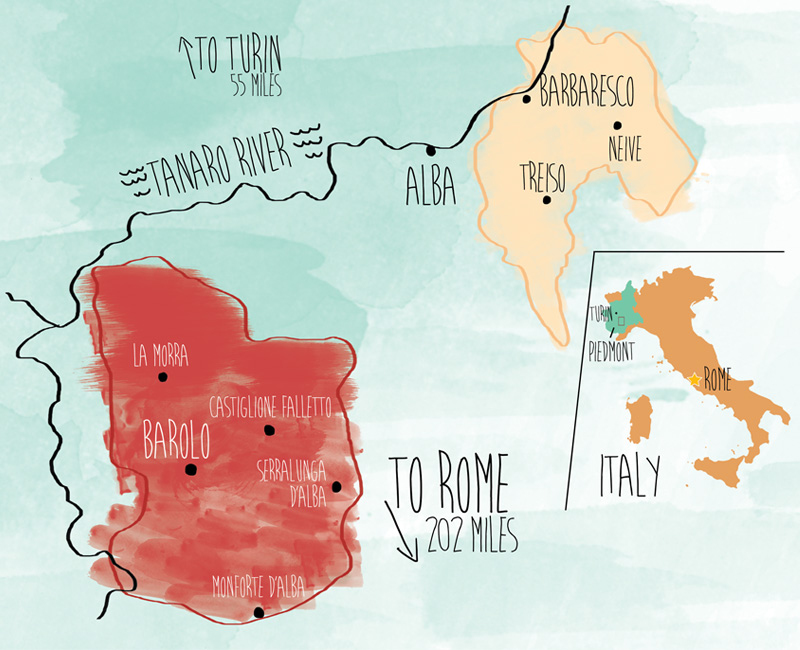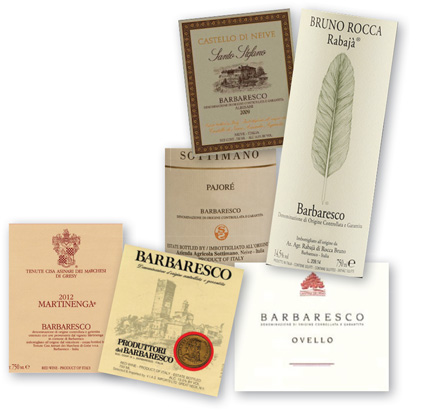Gianpaolo Paterlini was raised on Italian wine. His father, Giancarlo, in San Francisco’s Nob Hill neighborhood in 1989, and opened Acquerello Gianpaolo began busing tables there during high school. He gravitated to the wines of Piedmont right from the start.


Paterlini worked as a sommelier at Michael Mina for two years before returning to Acquerello. He became wine director in 2010 and has built the wine list into a powerhouse, with close to 2,000 selections covering all corners of Italy, Piedmont’s nebbiolo-based wines holding center stage. He’s organized the eight pages of Barbaresco by commune or village (Barbaresco, Neive and Treiso) and then by cru from north to south. All of the big-name producers are there, but the emphasis is squarely on the vineyards. For beginners, it’s a roadmap to the appellation; connoisseurs will find a treasure trove for exploring the nuances of each cru as interpreted by different producers.
Paterlini sees Giacosa and Angelo Gaja as pivotal figures in Barbaresco. “These two wineries have represented the face of Barbaresco for decades, and both continue to make amazing wines.” However, when asked to highlight six wines that capture the region now, he chose to omit them from his list below, “not for lack of quality—I love them both—but so I could shine the spotlight on some less recognizable wineries.”
He avoids the conventional winemaking debate of modernists versus traditionalists, a conversation he believes is painfully outdated. “The vast majority of Barbaresco and Barolo being made today
represent a middle ground that is responsible for the purest expressions of terroir the area has ever seen. The so-called ‘traditionalists’ have embraced modern technology to harvest riper grapes in the vineyard and make cleaner wines in the cellar. The ‘modernists’ are moving away from new oak and barriques, instead embracing a combination of used barriques or tonneaux and the large botti that the previous generation used.”


1. Produttori del Barbaresco Barbaresco
“This wine is the perfect introduction to Barbaresco,” says Paterlini. “It’s the one wine that you really need to know.” He points out that Barbaresco has a much shorter history than Barolo, and most of the wineries on this list are relatively young, but Produttori is the exception. It was founded in 1958 when the village priest brought together 19 grower families to pool their resources. “Produttori remains a cooperative today and its growers have land in most of the best vineyards. Their single-vineyard bottlings are amazing, and tasting all nine in a flight is one of the best ways to understand the diversity of Barbaresco, but it is their classic Barbaresco that steals the show. It’s a blend of all their vineyard holdings and makes one of the most consistent wines in the area—and one of the best values in the world of wine today.”
2. Cantina del Pino Barbaresco Ovello
This cantina is a small, family-owned property that sold grapes to the Produttori until 1997, when third-generation proprietor Renato Vacca bottled the estate’s first vintage. Paterlini chose it as an expression of one of the higher-elevation plots within the village of Barbaresco. “The family has a prime piece of the Ovello vineyard, one of the classic parts of Barbaresco and its northernmost vineyard. The high elevation and proximity to the Tanaro River result in a wine that is linear, vertical in structure, mineral and fresh in fl avor.” Paterlini likes it so much that he bottled a barrel from the 2010 vintage as a private label for Acquerello.
3. Marchesi di Gresy Barbaresco
Martinenga Like Cantina del Pino, Marchesi di Gresy also used to sell its fruit to Produttori, until 1973, when according to Paterlini, “the universally recognized greatness of Martinenga (the only monopole in Barbaresco) allowed them to start making wine on their own sooner than others.” The vineyard lies in the middle of a south-facing amphitheater, flanked by the famed Asili and Rabajà crus. “Martinenga is in the geographic center of the Barbaresco village, and most people will tell you it’s the best vineyard in Barbaresco, combining elegance and finesse with power and concentration to yield one of the most balanced Barbarescos. It’s very consistent, and I like it almost every vintage; even off-vintages exceed expectations.”


4. Bruno Rocca Barbaresco Rabajà
Bruno Rocca is yet another grower who sold grapes to the Produttori before bottling his own wines in 1978. He owns part of the Rabajà cru, a vineyard that’s in the southeastern corner of the Barbaresco village, with just a small road separating it from the Neive commune. “It’s on the same hillside as the south-facing Martinenga, but at Rabajà the hill turns a little toward the west and the soils have more clay; the character becomes more meaty, rich, almost like Neive: dark and juicy with a rounder, more mouthfilling texture than other vineyards in the village. Rocca embraces the character of Rabajà by making an almost chewy Barbaresco loaded with concentrated dark fruit.” Paterlini notes that Bruno’s children have been involved at the winery for a few years now. “The changes they’ve implemented are resulting in wines that today are better than ever.”
5. Sottimano Barbaresco Pajorè
Sottimano’s cellar is in the Neive commune, and he’s best known for his Barbarescos from Neive crus like Currà, Cottà and Fausoni, but Paterlini’s favorite is usually his Barbaresco from the Pajorè vineyard in Treiso commune. “If Barbaresco is known for its purity of fruit and Neive for its power and structure, Treiso is typically more savory. The soil may be a little more calcareous than sandy, but elevation is the key to its more mineral style. Pajorè is arguably the best vineyard in the village (it makes up a big part of Gaja’s classic Barbaresco) and Sottimano’s version is the best. It is a graceful expression of red fruit, sweet herbs and spices.”
6. Castello di Neive Barbaresco
Albesani Vigna Santo Stefano Paterlini chose this wine as a classic representation of the wines of the commune of Neive. “Santo Stefano is so famous that until the vineyard maps were recently made official, most people didn’t realize Santo Stefano is actually in the Albesani cru. Castello di Neive owns an amazing parcel, so big that they were able to sell grapes to Bruno Giacosa for almost fi y years.” Paterlini finds Giacosa’s Santo Stefano amazing, but Castello di Neive’s version is excellent and much more affordable. “It shows the depth and power of the clay soils that distinguish the village of Neive. The wine is a little like those from Rabajà, but a bit more structured and less fruit driven.”
This story was featured in W&S Fall 2016.
illustration by Veronica Collington
is the Italian wine editor at Wine & Spirits magazine.
This story appears in the print issue of fal 2016.
Like what you read? Subscribe today.
















